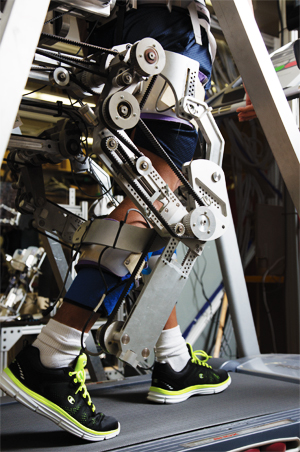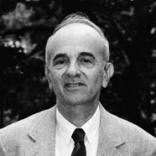Sunil Agrawal
Personalized Medicine Robots to the Rescue

Science is often about inspiration. “Aha!” moments can result in ideas that can help solve problems or interpret situations differently. For Sunil Agrawal, professor of mechanical engineering and rehabilitative medicine, the inspiration to design innovative robots and human-machine interfaces that enable people with impairments is close to his heart.
“Having seen my father suffer from Parkinson’s disease in his late years, I have observed, firsthand, the debilitating effects of neurological disorders on gait and motion functions,” he confides. That very personal motivation has led to pioneering work in robotic exoskeletons and robotic interfaces to help adults and children move more easily or retrain their bodies to regain lost function. The work has resulted in 10 new U.S. patents in the last five years, with an additional dozen currently under review.
“Robotics can help people who suffer from Parkinson’s or Lou Gehrig’s disease maintain muscle health. For children born with medical conditions such as cerebral palsy, spina bifida, and scoliosis, robotics can help alleviate the effects of these diseases on their lifespan,” says Agrawal, who directs the Robotics and Rehabilitation Laboratory (ROAR) and Robotic Systems Engineering Laboratory (ROSE), located at both the Engineering School and Columbia University Medical Center.

ALEX III (Active Leg Exoskeleton, Version 3) is designed to help in retraining of gait of human subjects. The drive motors, along with force and motion sensors within the robot, modulate in real-time the machine applied forces on the human leg so that the motion of the leg is closer to a specified template, shown to the user on a screen.
While robotic exoskeletons have previously been the stuff of science fiction, research in Agrawal’s lab has helped advance the science to a point where robotic interfaces and exoskeletons are closer to real-world application. Cleverly designed to conform to the degrees-of-freedom within the skeleton of the human body, these devices are powered by motors that supplement the forces provided by the muscles and interact with the wearer—similar to the brain-controlled suit that helped a paralyzed Brazilian teenager kick a soccer ball at the World Cup opening ceremony.
“Neural disorders caused by stroke and spinal cord injury limit a person’s ability to do things we all take for granted: reach and raise our arms, walk, and perform activities of daily living. My research is aimed at helping these people accomplish everyday tasks.”
Perhaps some of the most fulfilling results from Agrawal’s research come when he sees how his work in robotics and movement has helped improve people’s ability to walk or use their arms again after a stroke or cerebral accident.
“I have seen stroke survivors learn to walk faster and with a more natural gait after several weeks of training with our robotic exoskeletons,” Agrawal says. “We have developed wire-driven arm and leg exoskeletons that can help train limb movements of adults neurally impaired by stroke. We have also designed robots that help infants and toddlers as young as six months learn to be mobile in their environment. I have seen how this technology changes lives.”
In addition to working on technology that improves patient outcomes, Agrawal receives funding from the National Science Foundation for novel design, trajectory planning, and control of intelligent machines like free-floating robots that can operate in the micro-gravity conditions of space, as well as for cable-actuated robotic platforms.
Agrawal’s robotic exoskeletons for arms, legs, torsos, and neck also help physical therapists provide frequent and intense therapy on patients to help build muscle memory, which can restore functionality.
“Robots can be similar to training wheels on a bicycle. They help the user gain proficiency in function until their support is no longer needed,” he says.
For infants and toddlers, Agrawal and his team have designed and tested novel mobility enhancement robots and control interfaces that have the ability to teach six-month-old infants seated on a mobile robot to purposefully drive using a joystick, and also to maneuver the robot in cluttered environments in their home using a force-feedback joystick. “This technology can help a child with limited mobility to interact with others and not be left far behind in achieving childhood milestones,” he explains.
Agrawal joined Columbia Engineering in 2013. Prior to that, he was a professor of mechanical engineering and director of the Mechanical Systems Laboratory and Rehabilitation Robotics Laboratory at the University of Delaware. His PhD advisor at Stanford University was Professor Bernard Roth who was the first PhD student under the guidance of Professor Ferdinand Freudenstein at Columbia University. Agrawal is an active contributor to the Institute of Electrical and Electronics Engineering and the American Society of Mechanical Engineers. He currently serves as chair of the ASME’s Design Division, which has more than 11,000 active ASME members.
Always on the lookout for novel approaches to solving problems, Agrawal is also targeting a new and growing population who will likely benefit from even more advanced robotic applications: seniors.
“As we age, our musculoskeletal and sensory systems decay, leading to a variety of health issues. This is getting to be a pressing challenge for our rapidly aging society,” he says. “We are currently developing and testing novel exercise and sensory interfaces for the elderly to enhance their balance and prevent fallrelated morbidities. Robotic technologies will be a substantial solution to keep our older population healthy and safe.”
Behind Modern Kinematics Ferdinand Freudenstein Alumnus and Former Faculty

Often called the father of modern kinematics, Ferdinand Freudenstein PhD’54 (1926–2006) developed what became known as the Freudenstein equation, which utilizes an algebraic method to determine the positions of output levers in linkage mechanisms. After he received his doctorate degree from Columbia Engineering, the Department of Mechanical Engineering quickly offered him an assistant professorship. After less than four years, he became chair of the department and a full professor shortly thereafter.
By the beginning of the 1960s, Freudenstein’s kinematics program was known around the world, attracting top engineers and shaping hundreds of students. He was nearly as well known for his teaching as the brilliance of his scholarship, winning the Great Teacher Award in 1965. Freudenstein’s work, in analytical kinematics, dynamics of mechanisms, and industrial applications, led to numerous patents and consulting work with many major corporations. He was also appointed an honorary life fellow of the American Society of Mechanical Engineers.
His story began in Germany, from which he fled Nazi persecution in the 1930s. He lived briefly in Wales and Trinidad before securing entry to the United States in 1942. He served in the U.S. Army and studied at New York University, Texas A&M, and Harvard, earning a master’s in mechanical engineering. After working for the American Optical Company, he reached the Engineering School—where he would remain for the rest of his career—to pursue doctoral research in kinematics of mechanisms.
A few years after his 1979 induction to the National Academy of Engineering, Freudenstein was named Higgins Professor of Mechanical Engineering at Columbia Engineering, a title he retained until his death in 2006. His legacy lives on at the School, particularly in research and innovation in the fields of robotics, microelectromechanical systems, and biochemical engineering.
